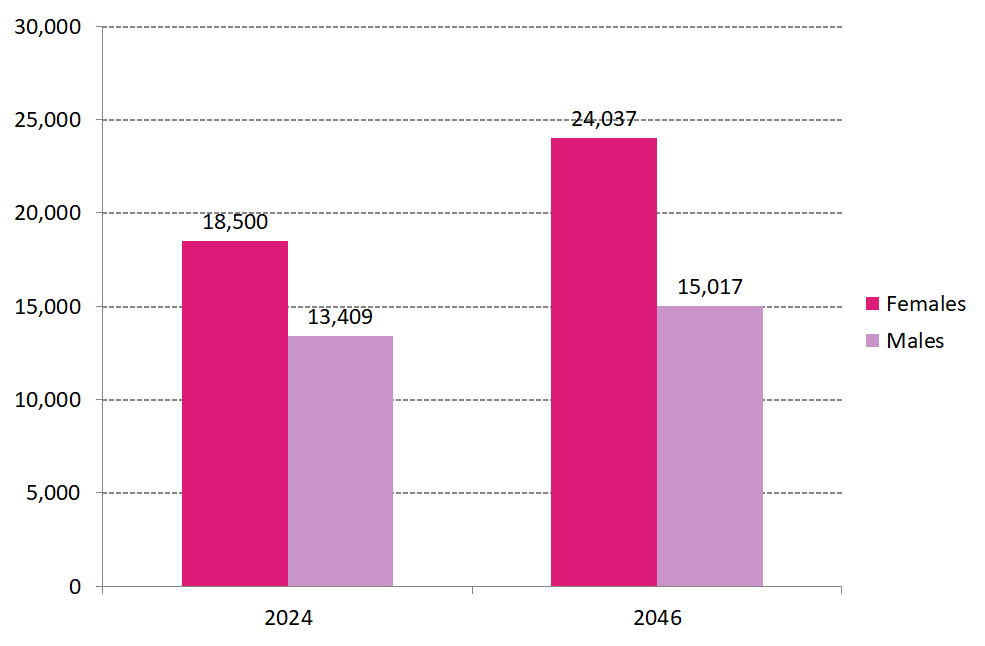This factsheet provides demographic information about older people living in the City of Whitehorse.
Population of Older People in Whitehorse
The City of Whitehorse has a higher proportion of older residents for all age groups over 60 years, particularly for those 85 years and older, in comparison with Greater Melbourne. In 2021, 23.8 per cent of the Whitehorse population were aged 60 years and over, compared with 20.2 per cent for Greater Melbourne.
People Aged 60-69 Years
In 2021, people aged between 60 and 69 years made up 10.1 per cent of the City of Whitehorse’s population compared with 9.5 per cent for Greater Melbourne. The proportion of people in this age group varied across different suburbs in the municipality from a low of 7.6 per cent in Box Hill to a high of 12.8 per cent in Mont Albert. The five suburbs with the highest percentages were:
- Mont Albert (14.7%)
- Vermont South (12.5%)
- Surrey Hills (12.1%)
- Mont Albert North (11.1%)
- Blackburn (10.8%)
People Aged 70-84 Years
In 2021, 10.5 per cent of the Whitehorse population were aged 70-84 years compared to 8.6 per cent for Greater Melbourne. The proportion of people in this age group varied across different suburbs in the municipality from a low of 7.4 per cent in Box Hill to a high of 16.2 per cent in Vermont South. The five suburbs with the highest percentages were:
- Vermont South (16.2%)
- Burwood East (14.1%)
- Forest Hill (12.7%)
- Blackburn South (11.8%)
- Mont Albert North (11.4%)
People Aged 85 Years and Over
In 2021, 3.2 per cent of the City of Whitehorse’s population were aged 85 years and over compared to 2.0 per cent for Greater Melbourne. The proportion of people in this age group varied across different suburbs in the municipality from a low of 1.9 per cent in Mitcham to a high of 4.4 per cent in Blackburn South. The five suburbs with the highest percentages were:
- Blackburn South (4.4%)
- Forest Hill (4.2%)
- Blackburn (3.7%)
- Burwood (3.7%)
- Nunawading (3.6%)
Population Forecast
In the City of Whitehorse, between 2024 and 2046 the number of persons aged 65 years and over is expected to increase by 9,604 persons (29.4 per cent) and comprise 18.1 per cent of the total population. The majority of 65 to 85+ year olds are forecast to reside in the suburbs of Box Hill, Vermont South, Blackburn and Mitcham.
Gender Forecast of Older People
The population of males and females aged 65 years and over is forecast to increase by a total of 9,597 persons between 2024 and 2046, which comprises of an increase of 5,537 females and 1,608 males.

Country of Birth
In 2021, 45.8 per cent of people aged 65 plus years in the City of Whitehorse were born overseas, and 38 per cent were from a non-English speaking background, compared with 46.2 per cent and 36.1 per cent respectively for Greater Melbourne.
Typically, older populations are more likely to have been born overseas. While China accounts for the greatest number of residents born overseas, there are some differences compared to young people, with migration from Europe more dominant among those over 65, while Asian countries such as India, Malaysia and Sri Lanka are more common birthplaces among younger people.
The largest non-English speaking country of birth for people aged 65 or more in the City of Whitehorse in 2021 was China, where 9.1 per cent or 2,840 people aged 65 years or more were born. This was followed closely by the United Kingdom (5.8 per cent) and Greece (4.0 per cent).
Life Expectancy
Overall, the City of Whitehorse experiences good health and wellbeing, with the average male in Whitehorse expected to live to the age of 85, and female to the age of 87.6. This is higher than the state average of 81.7 years for males and 85.7 years for females (Department of Health, 2019-2021).
Disability
The 2021 Census identified 9,374 people or 5.5 per cent of the population in the City of Whitehorse as needing help in their day-to-day lives due to disability. Of these, 64.7 per cent of people with a disability are aged 65 or over. People over the age of 65 often experience multiple disabilities, which are most commonly physical and sensory/speech related disabilities.

Source: ABS (2022), Census of Population and Housing 2021
Employment Status
In 2021, 3,801 people aged 65 years or more living in the City of Whitehorse were employed, with 34.7 per cent working full time and 55.2 per cent part time.
Volunteering and Unpaid Care
According to the 2021 Census, 16.4 per cent of people aged 65 plus volunteer for an organisation or group. In the same year there were 4,398 carers aged 65 plus in the City of Whitehorse providing unpaid assistance to a person with a disability, long term illness or old age.

Source: ABS (2022), Census of Population and Housing 2021
In 2021, 11.5 per cent of people in Whitehorse aged 65 years or more were in households that earned a high income and 42.1 per cent were in low income households, compared with 12.4 per cent and 42.3 per cent respectively for Greater Melbourne.

Source: ABS (2022), Census of Population and Housing 2021
Analysis of the household types of people aged 65 years or more in the City of Whitehorse in 2021 shows 47.7 per cent were in couple families without children, 14 per cent were in couple families with child(ren) and 6.9 per cent were in one-parent families.
The 2021 Census shows a total of 15,882 lone person households in Whitehorse. Of this, 7,569 (47.7 per cent) people aged 65 plus years live alone in Whitehorse.
Links
For more information about Older Persons please refer to:








